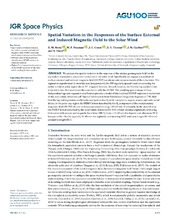| dc.contributor.author | Shore, R.M | |
| dc.contributor.author | Freeman, MP | |
| dc.contributor.author | Coxon, John C. | |
| dc.contributor.author | Thomas, EG | |
| dc.contributor.author | Gjerløv, Jesper | |
| dc.contributor.author | Olsen, N. | |
| dc.date.accessioned | 2020-06-15T15:21:58Z | |
| dc.date.available | 2020-06-15T15:21:58Z | |
| dc.date.issued | 2019-07-05 | |
| dc.Published | Shore R, Freeman M, Coxon JC, Thomas E, Gjerløv J, Olsen N. Spatial Variation in the Responses of the Surface External and Induced Magnetic Field to the Solar Wind. Journal of Geophysical Research (JGR): Space Physics. 2019;124(7):6195-6211 | eng |
| dc.identifier.issn | 2169-9402 | en_US |
| dc.identifier.issn | 2169-9380 | en_US |
| dc.identifier.uri | https://hdl.handle.net/1956/22596 | |
| dc.description.abstract | We analyze the spatial variation in the response of the surface geomagnetic field (or the equivalent ionospheric current) to variations in the solar wind. Specifically, we regress a reanalysis of surface external and induced magnetic field (SEIMF) variations onto measurements of the solar wind. The regression is performed in monthly sets, independently for 559 regularly spaced locations covering the entire northern polar region above 50° magnetic latitude. At each location, we find the lag applied to the solar wind data that maximizes the correlation with the SEIMF. The resulting spatial maps of these independent lags and regression coefficients provide a model of the localized SEIMF response to variations in the solar wind, which we call “Spatial Information from Distributed Exogenous Regression.” We find that the lag and regression coefficients vary systematically with ionospheric region, season, and solar wind driver. In the polar cap region the SEIMF is best described by the B y component of the interplanetary magnetic field (50–75% of total variance explained) at a lag ∼20–25 min. Conversely, in the auroral zone the SEIMF is best described by the solar wind ϵ function (60–80% of total variance explained), with a lag that varies with season and magnetic local time (MLT), from ∼15–20 min for dayside and afternoon MLT (except in Oct–Dec) to typically 30–40 min for nightside and morning MLT and even longer (60–65 min) around midnight MLT. | en_US |
| dc.language.iso | eng | eng |
| dc.publisher | Wiley | en_US |
| dc.rights | Attribution CC BY | eng |
| dc.rights.uri | http://creativecommons.org/licenses/by/4.0/ | eng |
| dc.title | Spatial Variation in the Responses of the Surface External and Induced Magnetic Field to the Solar Wind | en_US |
| dc.type | Peer reviewed | |
| dc.type | Journal article | |
| dc.date.updated | 2020-02-05T09:52:59Z | |
| dc.description.version | publishedVersion | en_US |
| dc.rights.holder | Copyright 2019 The Author(s) | en_US |
| dc.identifier.doi | https://doi.org/10.1029/2019ja026543 | |
| dc.identifier.cristin | 1771584 | |
| dc.source.journal | Journal of Geophysical Research (JGR): Space Physics | |

